
Features
Crop Culture
Inputs
Growing in the Green: Some like it really hot
April 29, 2009 By Melhem Sawaya
Some like it hot! Last month, I shared with you some of the cool crops and production of pansy as the mother of all cool crops. In this month’s article, I want to discuss some of the crops that do better when the days are longer and the temperature is much warmer.
Some like it hot! Last month, I shared with you some of the cool crops and production of pansy as the mother of all cool crops. In this month’s article, I want to discuss some of the crops that do better when the days are longer and the temperature is much warmer.
The main purpose for last month’s article on cool crops and this month’s hot crops is to stress the point of working with Mother Nature, with respect to crop culture, and not against her.
This is very important for two main reasons.
The number one reason is economical. Every time we try to provide culture conditions artificially, we are spending extra energy on such factors fuel, hydro, structural issues and labour. This is true whether we are trying to grow a cool-loving crop in warm weather or a hot-loving crop in cool weather.
When we grow pansy in the summer for fall sales, we find it is not as easy in the hot months. It’s more costly because more plugs are needed to make a full container, there is much more chance of disease, and the window between a crop being at its prime condition or turning ugly is very short. We should also note that in Canada, planting pansies in the fall is not yet a popular concept.
On the other hand, as we mentioned in last month’s issue, pansy is the number one cool crop. The same goes if we try to grow osteospermum, primula, alyssum (annual and perennial), and many of the perennial cultivars. They look excellent in early spring, but often resemble weeds the rest of the summer.
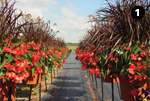
|
|
| “Dragonwing Begonia” and “Purple Fountain Grass” | |

|
|
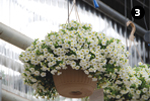
|
|
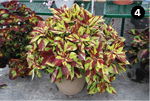
|
|
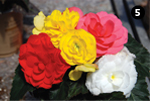
|
|
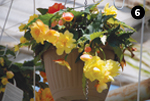
|
|
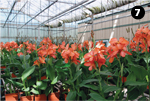 |
|
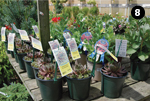 |
|
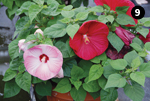
|
|
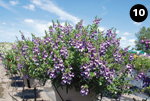
|
|
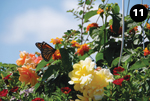 |
|
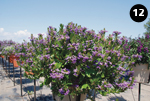
|
|
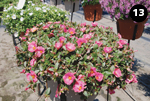
|
|
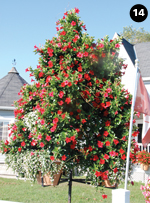
|
|
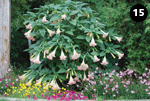
|
|
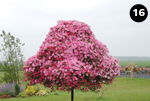 |
|
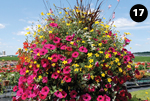
|
|
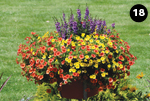
|
|
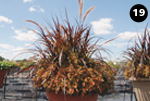
|
|
|
|
SELLING THE RIGHT CROP,FOR THE RIGHT SEASON
The second reason is selling customers the right crop for the right season; cool crops in April and hot crops in June and July. Selling bowls of pansies in April is a joy for all consumers until June or later. Selling angelonia in April will result in total customer dissatisfaction, while marketing angelonia from June to October is one of the best strategies and guarantees consumers will be extremely satisfied.
We still produce many crops for early market for no other reason than tradition. They are very costly to produce and are contrary to Mother Nature’s conditions. Some examples are dianthus, snapdragon, blue salvia, cleome and double petunia. They are much more economical when targeting a May 20 date rather than April 20.
Targeting the correct date means we will have crops that don’t need any growth regulators. Sometimes, as growers, when growing a crop that will become tall in low light or short days, we try to compensate by applying extra growth regulators that will have a negative effect on the crop’s quality.
Here are some of the crops that not only can handle the summer heat, but love it.
The “Dragonwing Begonia” and “Purple Fountain Grass” combination (1) is one of the most flourishing combinations that put on a good show the whole summer long and into the fall. This combo loves the heat and looks better as the summer goes on.
PETUNIAS LOOK GREAT, EVEN DURING COOL SPELLS
Petunia (2) is a species that looks good in flowerbeds, hanging baskets, combinations, and can even stand the cool weather. It looks great in the summer heat and into late fall as long as it is fertilized continuously.
Calibrachoa (3) can take moderately cool weather, but not as well as petunia can. Calibrachoa is very floriferous due to its small flowers and puts on the best show throughout the summer and regardless of how hot it gets. It is a full sun plant that looks great in small or large containers and adds great colour and texture to any combination without taking over the whole container, like petunia can.
Coleus (4) is a very versatile crop. However, it cannot take the cold, so don’t sell early or grow it in a very cool area. Coleus is a hot crop and, especially with the introduction of so many cultivars, has a tremendous selection of colour. Coleus stands out the whole summer and especially when it is hot. It loves the sun and even the seed varieties thrive. It is one of the few cultivars that can look good in shade areas. But if you want to see the vibrant bright contrast of colours in a coleus leaf, then look at it grown in full sun, the warmer the better!
So many kinds of begonia (5) love the summer heat and every one looks good, even the tuberous begonia. They put on a good show in full sun as long as they are acclimatized in the greenhouse by being grown in full sun prior to being sold and exposed to full sun outdoors. Begonia is extremely floriferous when grown in full sun and, comparatively, okay in the shade. The Illumination Tuberous Begonia (6) does better that the upright varieties.
Cannas, with the introduction of the Tropical Series (7) from seed cannas, provide a more powerful enticement because they are already flowering at sales date. Their blooms immediately beautify any garden with their variety of colours and continue to show well through the summer.
SUCCULENTS WILL THRIVE IN FULL SUN AND HIGH HEAT
Succulents (8) are especially great summer crops since they are very tolerant of drought and can take full sun and high heat. Also, many succulents are perennials to Zones 4 and 5. Combinations of succulents look very good the whole summer long.
Many perennials can take the heat and sun but don’t like the cold. As a matter of fact, they don’t peek their head from the ground until June when the ground temperature starts to warm up. But once they start, they grow through the summer. The warmer it is, the better they like it. A good example of this is hibiscus. (9) Angelonia (10), sometimes called Summer Snapdragon, loves heat and sun, whether in flower beds, large containers or combinations. Angelonia goes yellow, even in the greenhouse, if grown below 15℃. The warmer, the better for angelonia, so let us not sell it until after May 20.
Lantana (11), shown here in combination with tuberous begonia and calibrachoa, is another plant that thrives in heat and sunny conditions. With continuous colour the whole summer, it is especially attractive to butterflies. The sunnier it is, the more colour it shows.
SCAEVOLA IS THE BEST SUMMER FLOWERING PLANT
Scaevola (12) is, by far, the best summer flowering plant that will look great the entire summer. No deadheading is required. It features loads of blooms and they only increase with more sun and heat. Scaevola is excellent in large containers, flower beds and combinations.
Portulaca (13) (Pursalane) is a flowering succulent plant that can tolerate drought and loves hot, sunny summers. It is excellent for cottages or homes lacking available plant watering for three to five days.
Sanvitalia is a plant that is full of small, yellow flowers. It doesn’t do much the whole winter in the greenhouse, but when summer heat and sun hit sanvitalia, it explodes in growth and flowers. No deadheading is needed for this continuously flowering lover of heat and high light. It is excellent alone in large containers or in combinations.
Diplodinia Mandivilla (14) is a plant that will only flower freely under long days and will increase in floriferousness with high light and temperature. In our trials, the Diplodinia Mandivilla was a top performer and, when the local hospital holds its plant sale, it is the first plant that goes. Breeding is on the increase as many suppliers recognize its impact on consumers. I am sure many new suppliers are on the way.
Another plant that does well in the summer is Brugmansia (15). With its colourful bells, it puts on a show that consumers want to have in their yards. Brugmansia loves the heat and light and is a definite summer plant. It must not be sold early.
Good flowers don’t grow on trees (16). Do they? Here’s a few impressive combos (17 and 18) of heat-loving plants. Purple fountain grass and coleus (19) are great summer performers.
When we know a plant won’t survive cool temperatures, we shouldn’t grow or sell it until Mother Nature enhances the product by providing the optimum environmental conditions.
If the consumer is not successful with what we sell them, they will not buy anything any more. Have the success of the consumer in mind and you will have a successful horticulture business.
Milhem Sawaya of Focus Greenhouse Management is a consultant and research co-ordinator to the horticultural industry. Comments on this or any other article are always welcome; please e-mail mel@focusgreenhousemanagement.com, or visit www.focusgreenhousemanagement.com or www.sawayagardentrials.ca.
Print this page